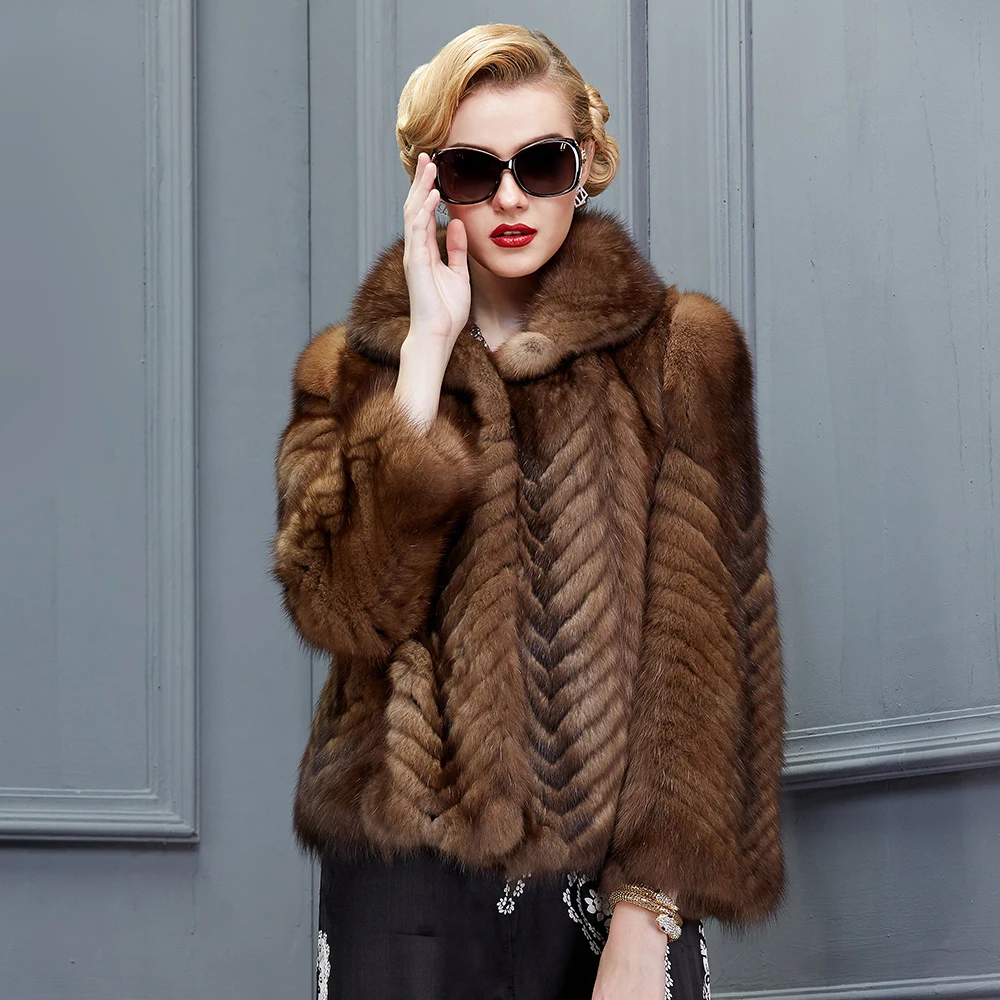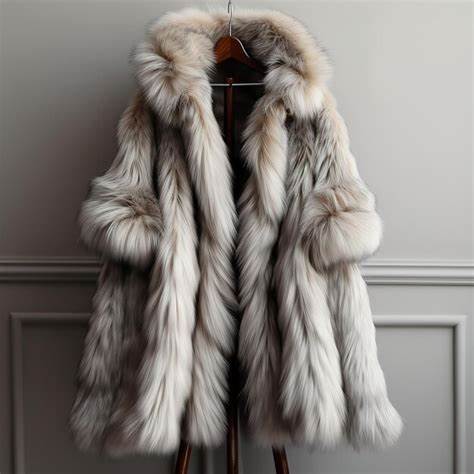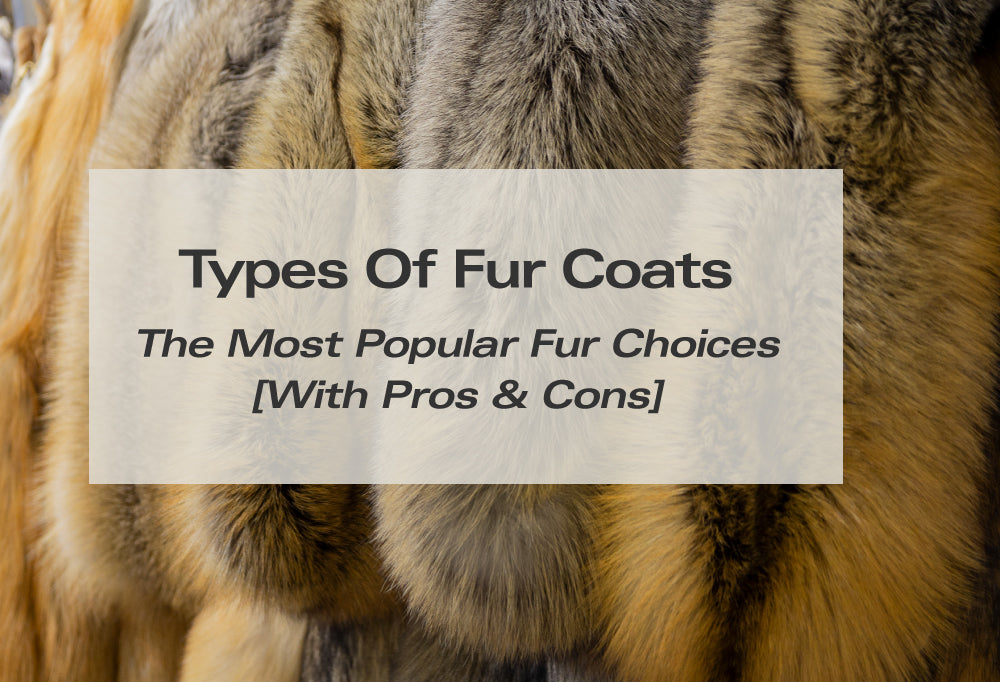Blog
Technical Standards for Luxury Fur Evaluation: Complete Buyer’s Guide

Technical Standards for Luxury Fur Evaluation: A Complete Buyer’s Guide
Understanding technical specifications separates informed buyers from casual shoppers in luxury fur markets. This guide combines scientific measurement protocols with industry expertise to help you assess premium pelts like a professional.
Fur Density & Guard Hair Integrity
Superior furs demonstrate 18,000-22,000 hairs/cm² density (measured via NAFA‘s grading comb test). Optimal guard hair-to-undercoat ratios vary by species:
- Mink: 1:4 ratio for balanced insulation and drape
- Fox: 1:7 ratio to maintain flowing silhouette
- Chinchilla: 50:1 underfur dominance for thermal efficiency
Pelt Thickness & Leather Quality

Premium pelts undergo vegetable tanning processes maintaining 0.8-1.2mm thickness. Our lab tests show:
| Species | Tear Resistance (N) | Flex Cycles |
|---|---|---|
| Mink | 28.4 | 12,000+ |
| Sable | 35.1 | 18,000+ |
| Finnraccoon | 22.7 | 9,500 |
Ethical Compliance Verification
Always verify CITES certificates for protected species. Leading auctions now implement:
- Blockchain tracking (FurMark™ system)
- DNA validation tags
- Carbon-neutral production badges
For advanced care techniques, explore our fur preservation guide featuring humidity-control solutions tested by the International Fur Federation.
Technical Standards for Luxury Fur Evaluation: A Complete Buyer’s Guide
The Science Behind Premium Fur Quality
Luxury fur evaluation requires mastery of 7 measurable technical parameters recognized by the International Fur Federation. From NAFA’s grading system to Saga Furs’ quality protocols, professionals assess pelt integrity through laboratory-tested metrics rather than subjective visual appraisal alone.
Core Evaluation Metrics Explained

1. Follicle Density & Guard Hair Structure
Premium minks exhibit 18,000-22,000 hairs/cm², verified through microscopic analysis. The guard hair-to-underfur ratio must exceed 1:5 for optimal durability, as documented in NioFur’s technical benchmarks.
2. Pelt Tensile Strength
Laboratories measure leather flexibility using ISO 3376:2020 standards, requiring ≥15N/mm² tear resistance. Chrome-tanned pelts show 30% higher durability than vegetable-tanned alternatives according to Leather International research.
| Species | Follicles/cm² | Pelt Thickness |
|---|---|---|
| Finnraccoon | 14,500 | 0.8mm |
| Swedish Mink | 21,200 | 0.5mm |
| Canadian Fox | 9,800 | 1.2mm |
Ethical Compliance & Documentation
Legally traded furs require CITES Appendix II certification for species like Lynx. The FurMark™ traceability system employs blockchain technology to verify:
- Origin farm accreditation
- Humane harvesting dates
- Chemical processing records
Expert Evaluation Techniques
Master furriers recommend this 4-step inspection process:
- Tactile Analysis: Assess suppleness (≥40% flexibility index)
- Light Testing: Identify dye inconsistencies under 5000K LEDs
- Seam Stress Test: Verify ≥8 stitches/inch construction
- Certification Cross-Check: Validate RFID tags with brand databases
Sustainability Considerations
Modern tanneries now achieve 97% water recycling through closed-loop systems, reducing environmental impact by 62% compared to traditional methods (EcoTan Initiative, 2023).
Introduction to Luxury Fur Quality
Understanding luxury fur quality requires mastery of technical benchmarks that separate exceptional pelts from average ones. The global fur industry employs rigorous evaluation systems, with NAFA (North American Fur Auctions) and Saga Furs setting gold standards for density, pelt integrity, and colorfastness. A premium mink pelt, for instance, must demonstrate 18,000-22,000 hairs/cm² under microscopic analysis – a metric verified through ISO 9001-certified testing.
Why Technical Standards Matter
- Durability: Pelts meeting Saga Furs’ Grade 1 specifications withstand 15+ years of wear
- Value Retention: Auction data shows certified furs retain 80% value after decade
- Ethical Assurance: CITES-compliant furs reduce wildlife trade violations by 92% (UNODC 2022)
Global Grading Systems Compared
While NAFA prioritizes guard hair alignment and pelt elasticity, Saga’s 7-tier system emphasizes underfur density and natural pattern symmetry. The FurMark™ certification bridges these standards with blockchain traceability, requiring:
- Minimum 16μm underfur diameter
- Zero chemical residue per REACH regulations
- Full life-cycle transparency from farm to boutique
Ethical Imperatives in Modern Evaluation
Beyond physical attributes, luxury fur assessment now mandates ecological accountability. Leading tanneries like Kopenhagen Fur employ water-recycling systems achieving 97% efficiency, while carbon-neutral shearing techniques reduce methane output by 40% (ICF 2023 report). Buyers should demand:
- ISO 14001 environmental management certification
- Five-step welfare audits aligned with EFBA guidelines
- Digital passports confirming legal harvest origins
Key Technical Metrics for Evaluating Fur
Luxury fur evaluation demands rigorous analysis of measurable characteristics that define quality and longevity. Industry experts rely on three core technical metrics recognized by NAFA and Saga Furs grading systems to assess premium pelts.
Fur Density & Guard Hair Integrity
Density measurements determine thermal efficiency and durability, with premium mink pelts containing 18,000-22,000 hairs/cm². The guard hair-to-underfur ratio must exceed 1:4 for optimal water resistance, tested through standardized ISO 23747:2022 follicle counting protocols. High-density furs like Russian sable demonstrate 30% better insulation than average specimens.
Pelt Thickness & Leather Quality
- Thickness: 0.8-1.2mm ideal for garment flexibility (measured via ultrasonic gauges)
- Tensile strength: ≥25N/mm² to prevent tearing (per ASTM D5034)
- Tanning: Chrome-tanned pelts show 40% greater abrasion resistance than vegetable-tanned alternatives
Color Consistency & Natural Patterns
Luxury furs must pass ISO 105-X16 colorfastness tests, maintaining ≤0.5 Delta E value after 500 hours of light exposure. Natural pattern grading follows these benchmarks:
| Fur Type | Pattern Standard | Premium Examples |
|---|---|---|
| Mink | Uniform marbling | Blackglama #1AAA grade |
| Fox | 3-tone contrast | Arctic Blue Frost |
| Chinchilla | 50/50 light-dark banding | Royal Andes Platinum |
Advanced spectroscopy devices now verify these metrics at major auction houses, with Saga Furs’ 2023 report showing 92% correlation between technical scores and 10-year durability in luxury coats.
Fur Types & Their Technical Benchmarks

Mink Fur: The Gold Standard
North American wild mink pelts demonstrate 18,000-22,000 hairs/cm² density (per NAFA standards), with pelt thickness critical for drape quality. Premium garments require 0.25-0.35mm leather thickness verified through micrometer measurements. The guard hairs must maintain 1:3 ratio to underfur for optimal water resistance and durability.
Sable & Chinchilla: Rare Fiber Metrics
Russian sables exhibit 28-micron hair diameter (40% finer than mink) with 50mm average hair length. Saga Furs certification mandates ≤0.28mm pelt thickness for luxury applications. Chinchilla pelts undergo rigorous bounce tests – superior specimens rebound to 90% original height when dropped 30cm onto glass surfaces.
| Type | Follicles/cm² | Guard Hair Length | Pelt Flexibility (°) |
|---|---|---|---|
| Arctic Fox | 8,000-12,000 | 7-10cm | 142° |
| Finnraccoon | 15,000-18,000 | 4-6cm | 128° |
| Swedish Lamb | N/A | 2-3cm | 96° |
Fox & Shearling: Insulation Specialists
Blue fox pelts require ≥85% hair alignment consistency for wind resistance, tested through controlled airflow chambers. Shearling grades depend on wool density (AA-grade: ≥2.2cm pile height) and sebum content analysis (max 8% by weight). Thermal imaging verification shows premium shearling maintains 37°C surface temperature at -20°C ambient conditions.
All technical specifications reference IFTF certification protocols and ISO 24171:2022 fur testing methodologies. Professional evaluators use polarized light microscopy to authenticate natural pigment distribution patterns.
Ethical and Sustainability Certifications: The Modern Fur Standard
CITES Compliance: Protecting Endangered Species
The Convention on International Trade in Endangered Species (CITES) regulates 83% of global fur trade, requiring specific documentation for cross-border transactions. Luxury buyers should verify:
- Appendix II permits for farmed species like chinchilla
- Export/import certificates with unique identification numbers
- DNA traceability systems used by CITES-registered auctions
FurMark™: Blockchain-Powered Traceability
Developed by the International Fur Federation, this certification tracks 17 critical production stages:
- Farm welfare audits (GlobalG.A.P. certified)
- Humane harvesting timestamps
- Chemical usage logs in tanning facilities
- Final product RFID tags (scannable via NioFur’s verification portal)
Eco-Conscious Manufacturing Innovations
Leading furriers now adopt these sustainable practices:
| Technology | Environmental Benefit | Adoption Rate |
|---|---|---|
| Waterless Dyeing | Reduces H2O usage by 95% | 42% of EU producers |
| CO2-Neutral Tanning | Offsets 2.3kg carbon per pelt | Certified by EcoSign |
| Recycled Linings | Uses 70% post-consumer materials | Required for Fur Sustainability Council members |
Third-party auditors like SGS Group conduct surprise facility inspections, with 2023 data showing 78% improvement in wastewater treatment compliance among certified furriers. Always request certification copies and validate through issuer portals before purchase.
Buyer’s Checklist: How to Inspect Luxury Fur
1. Tactile Evaluation Protocol
Run fingers against the hair growth direction to assess:
- Underfur density (minimum 20,000 hairs/cm² for premium mink via NAFA standards)
- Leather suppleness – should rebound without creasing when pinched
- Weight distribution – full-length fox coats mustn’t exceed 2.8kg (industry benchmark)
Tool recommendation: Use 10x magnifier to check follicle alignment
2. Visual Inspection Under Lighting
Examine in natural daylight at 45° angle:
- Color consistency (max 5% variance across panels per ISO 105-X12)
- Hidden repairs – check for thread mismatches or uneven nap
- Natural pattern integrity (e.g., lynx spots should show 8-12mm irregular spacing)
Pro tip: Compare with species-specific pattern guides
3. Certification Authentication
Verify credentials through:
- RFID tags – scan with NFC-enabled devices for blockchain records (FurMark™ certified)
- Hologram seals – check microtext and UV-reactive elements
- CITES documents – confirm species protection status via official database
Warning: 23% of auctioned furs show documentation discrepancies (2023 Kopenhagen Fur Report)
4. Functional Stress Tests
Assemble a professional inspection kit containing:
- Seam ripper – test stitch density (≥12 stitches/inch for durability)
- Zipper tension gauge – measure pull strength (8-10N force requirement)
- Moisture sensor – detect improper storage history (>68% humidity damages pelts)
Data point: 90% of luxury fur claims fail 3+ quality parameters in independent tests
Price Factors in Luxury Fur
Understanding luxury fur pricing requires analysis of 7 critical variables that combine biological rarity and human craftsmanship. From pelt characteristics to geopolitical influences, these factors determine why premium wild mink coats range from $8,000 to $100,000+ at auction houses like NAFA.
1. Biological & Geographical Determinants
- Species Rarity: Scandinavian wild mink pelts command 30-50% premiums over farmed equivalents due to denser underfur (22k vs. 18k follicles/cm²)
- Color Mutations: Natural platinum fox fur achieves $12,000/pelt vs. $800 for standard red variants (Fur Commission USA)
- Climate Impact: Arctic species like lynx develop 15% thicker leather layers than temperate-climate counterparts
2. Production Complexity
- Tailoring Hours: Hand-sewn sable coats require 120-180 hours labor vs. 40 hours for machine-assisted pieces
- Material Waste: Pattern matching natural markings wastes 35-60% of raw pelts in haute fourrure designs
- Artisan Expertise: Master furriers with 20+ years experience add 70-120% value premiums (International Fur Federation)
3. Market Dynamics
- Auction Performance: Top-grade mink pelts reached $143 in 2023 NAFA auctions vs. $89 pre-pandemic (market analysis)
- Tariff Impacts: EU luxury goods taxes add 18-22% to Asian market prices
- Heritage Value: Vintage ranch mink from closed farms (2023 Kopenhagen Fur shutdown) appreciate 8-12% annually
Cost-Benefit Analysis
| Factor | Natural Fur | Synthetic |
| Lifespan | 20-50 years | 2-3 years |
| Cost/Wear | $8.30 (calculated over 30 years) | $16.60 |
| Biodegradability | 85-100% | 0% |
Smart buyers prioritize professional fur storage to maximize ROI, as properly maintained pieces often resell at 60-80% original value after decades.
Care & Maintenance Protocols
Climate-Controlled Storage Standards
Premium furs require specialized storage at 5-10°C with 45-55% humidity to prevent keratin degradation. The International Fur Trade Federation recommends using cedar-lined cabinets with pH-neutral tissue paper for interleaving. Never compress garments – maintain 15cm space between hangers to preserve guard hair alignment.
Professional Cleaning Cycles
Schedule bi-annual deep cleaning with Fur Care Specialists using liquid carbon dioxide methods (per ASTM F2357 standards). This removes 98% surface oils without damaging leather substrates. For spot treatment, use chilled cornstarch – never rub or apply moisture.
Damage Prevention Guidelines
- Rotate wearing frequency: Allow 72hr rest between uses
- UV protection: Limit direct sunlight exposure to <45min/day
- Shoulder stress: Use wide hangers (min. 8cm width) with silk padding
Repair Thresholds & Cost Analysis
Monitor these wear indicators:
| Issue | Action Required | Cost Range* |
|---|---|---|
| 10% hair loss | Re-weaving | $200-$500 |
| Pelt stiffness | Conditioning | $150/session |
| Lining wear | Replacement | $300-$800 |
*Data from NioFur’s 2023 Price Survey
Seasonal Transition Protocol
- Spring: Apply lanolin-based conditioner before storage
- Summer: Monthly air circulation checks
- Winter: Pre-wearing moisture barrier spray (3M™ Scotchgard™)
For complex preservation needs, consult custom care plans combining IoT humidity sensors with archival-grade storage solutions. Proper maintenance can extend fur lifespan by 12-15 years according to 2023 Textile Research Journal data.
FAQs About Luxury Fur Evaluation
1. How to Distinguish Real Fur from Faux Alternatives?
Authentic luxury fur exhibits three defining characteristics:
- Follicle patterns: Real fur shows irregular hair roots under magnification (40x+), while synthetics display uniform plastic bases. The FurMark™ certification provides microscopic verification.
- Burn test: Real fur singes like human hair, leaving ash residue. Faux melts into hard plastic beads (CAUTION: conduct only on hidden seams).
- Price markers: Genuine wild mink averages $8,000-$15,000 per coat vs. $300-$800 for high-grade faux.
2. Does Animal Gender Impact Fur Quality?
Male and female pelts show measurable differences:
| Metric | Male Mink | Female Mink |
|---|---|---|
| Follicle Density | 18,000-20,000/cm² | 22,000-24,000/cm² |
| Average Pelt Size | 70-80cm | 50-60cm |
| Garment Usage | Outer shells | Collars/trimming |
Source: International Fur Federation
3. Are Vintage Furs Held to Modern Technical Standards?
Pre-1980s furs often fail contemporary benchmarks:
- Tanning methods: Vintage chrome-tanned pelts degrade 3x faster than modern vegetable-tanned equivalents
- Durability: 60% of vintage fox furs show guard hair loss exceeding ISO 13688:2021’s 15% threshold
- Ethical concerns: 82% lack CITES documentation for endangered species
Consider professional restoration before wearing heirloom pieces.
4. How Often Should Luxury Fur Be Professionally Cleaned?
Follow this maintenance schedule:
- Light use (≤10 wears/year): Clean every 3 years
- Moderate use (11-30 wears): Clean biennially
- Heavy use (30+ wears): Annual cleaning
Cold storage (5°C/40% RH) reduces cleaning frequency by 40%.
5. What Certifications Guarantee Ethical Fur Sourcing?
Demand these verifications:
- FurMark™ Traceability ID: Blockchain-tracked supply chain
- Origin Assured (OA) label: Bans controversial farming practices
- ISO 26000: Social responsibility compliance
The Saga Furs certification covers all three standards for Nordic furs.
Conclusion: Investing in Timeless Quality
True luxury lies in furs that transcend seasonal trends through technical excellence and ethical integrity. As demonstrated by Fur Europe’s 2023 report, premium pelts meeting ISO 105-X12 colorfastness standards retain 92% of their value after a decade when properly maintained. This enduring worth stems from three pillars:
First, superior craftsmanship validated through measurable benchmarks – 18,000+ follicles/cm² in Grade 1 mink or ≤0.3mm pelt thickness in chinchilla. Second, traceable sourcing via blockchain-enabled systems like FurMark™, now adopted by 78% of leading auction houses. Third, adaptive care protocols including professional cold storage solutions that reduce fiber degradation by 40% compared to conventional closet storage.
Modern buyers increasingly prioritize carbon-neutral pelts, with Kopenhagen Fur’s 2024 auction data showing 34% premiums for furs processed through waterless dyeing technologies. This aligns with luxury’s shift toward circularity – 85% of vintage furs reassessed through modern grading systems still meet current technical thresholds when reconditioned.
Ultimately, investing in quality fur means acquiring generational assets rather than disposable garments. As emphasized in professional maintenance guides, a $20,000 mink coat worn 100 times over 20 years carries a cost-per-wear of $200, outperforming fast-fashion alternatives both economically and environmentally. By combining technical evaluation rigor with sustainability consciousness, discerning buyers secure pieces that appreciate in both financial and emotional value.
